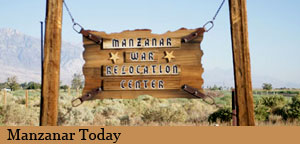- President George H.W. Bush, in a letter of apology to former internees, 1990
After the war, the federal government sold the barracks and other buildings and returned Manzanar to the city of Los Angeles. For the next four decades, local residents hunted, cut firewood, and harvested fruit from the original orchards.
For most Japanese Americans, returning home was difficult. By the end of the war, many American born Japanese resettled in the Midwest and on the East Coast with help from churches and other organizations. Parents faced the decision of whether to join their children in new communities or to return to their pre-war communities. Many had lost their homes, businesses, and farms. They were forced to start over again.
From the closing of camp in1945, to the first pilgrimage in 1969, Manzanar lay largely forgotten. However beginning in the 1970s, Japanese Americans and others worked for decades to insure that Manzanar would be preserved so that all Americans could learn this important part of our shared history.
On March 3, 1992 Congress established Manzanar National Historic Site, entrusting the National Park Service to preserve the site and tell its stories.




